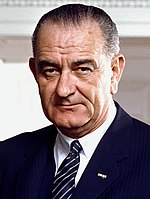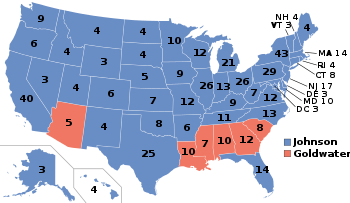1964 Presidential Election
|
|
|||||||||||||||||||||||||||||
|---|---|---|---|---|---|---|---|---|---|---|---|---|---|---|---|---|---|---|---|---|---|---|---|---|---|---|---|---|---|
|
|||||||||||||||||||||||||||||
|
All 538 electoral votes of the Electoral College 270 electoral votes needed to win |
|||||||||||||||||||||||||||||
| Turnout | 61.9% |
||||||||||||||||||||||||||||
|
|||||||||||||||||||||||||||||
|
Presidential election results map. Blue denotes those won by Johnson/Humphrey, red denotes states won by Goldwater/Miller. Numbers indicate the number of electoral votes allotted to each state.
|
|||||||||||||||||||||||||||||
|
|||||||||||||||||||||||||||||
The United States presidential election of 1964 was the 45th quadrennial presidential election. It was held on Tuesday, November 3, 1964. Democratic candidate and incumbent President Lyndon B. Johnson had come to office less than a year earlier following the assassination of his predecessor John F. Kennedy. Johnson, who had successfully associated himself with Kennedy’s popularity, won 61.1% of the popular vote, the highest win by a candidate since James Monroe’s re-election in 1820. It was the most lopsided US presidential election in terms of popular votes, and the tenth-most lopsided presidential election in the history of the United States in terms of electoral votes. No candidate for president since has equalled or surpassed Johnson’s percentage of the popular vote, and since 1820, only Abraham Lincoln in 1864, Franklin D. Roosevelt in 1936, Richard Nixon in 1972 and Ronald Reagan in 1980 and 1984 have won by a greater electoral vote margin.
...
Wikipedia




